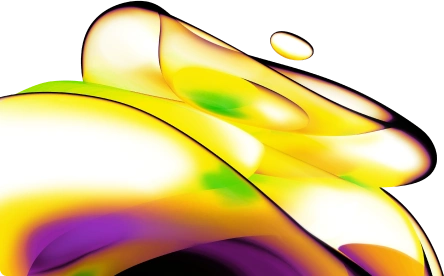

AlphaLISA SureFire Ultra Human and Mouse Phospho-α-Synuclein (Ser129) Aggregate Detection Kit, 100 assay points
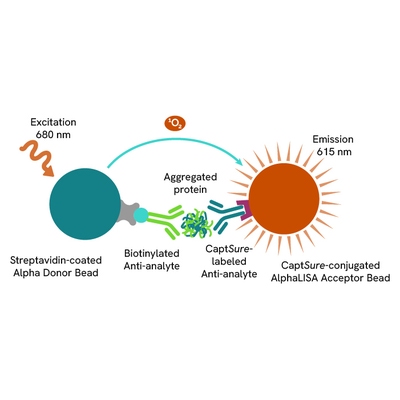
AlphaLISA SureFire Ultra Human and Mouse Phospho-α-Synuclein (Ser129) Aggregate Detection Kit, 100 assay points
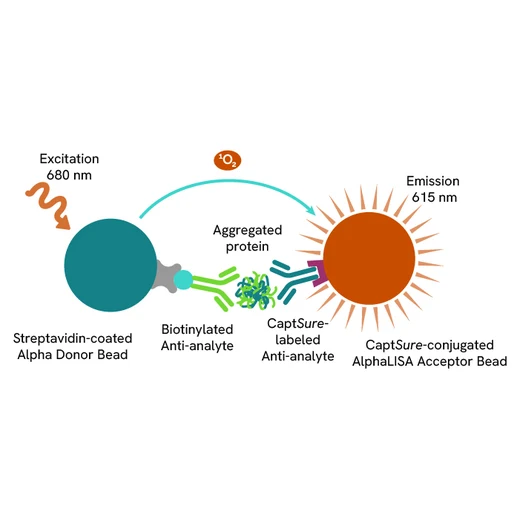
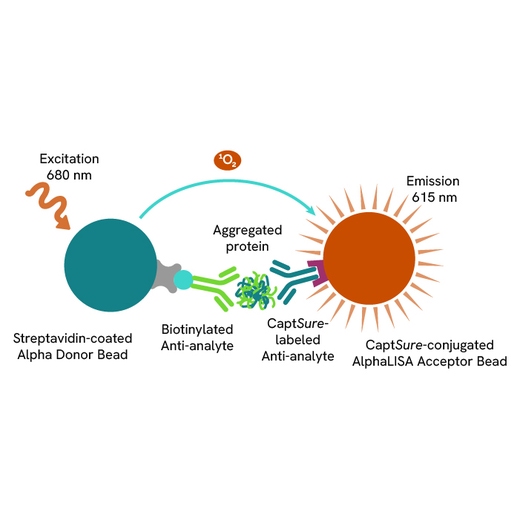
| Feature | Specification |
|---|---|
| Application | Cell Signaling |
| Protocol Time | 2h at RT |
| Sample Volume | 30 µL |



Product information
Overview
Alpha-Synuclein (α-Syn) is a small, intrinsically disordered protein predominantly expressed in neurons, particularly in presynaptic terminals. It plays a crucial role in synaptic function, vesicle trafficking, neurotransmitter release and synaptic plasticity. In its normal state, α-Syn exists as a soluble monomer, but it can misfold and aggregate into oligomers, fibrils, and Lewy bodies. These aggregates are a hallmark of synucleinopathies, including Parkinson's disease (PD), Dementia with Lewy Bodies (DLB), and Multiple System Atrophy (MSA). Misfolded α-Syn disrupts cellular homeostasis, impairs synaptic function, and propagates toxic fibrils between neurons in a prion-like manner, leading to neurodegeneration. Therapeutic strategies aim to reduce α-Syn aggregation, enhance its degradation, and prevent its pathological spread.
The AlphaLISA SureFire Ultra Human and Mouse Phospho-α-Synuclein (Ser129) Aggregate Detection Kit is a sandwich immunoassay for the quantitative detection of phospho-α-Synuclein (Ser129) aggregate in cellular lysates, using Alpha Technology.
Formats:
- The HV (high volume) kit contains reagents to run 100 wells in 96-well format, using a 60 μL reaction volume.
- The 500-point kit contains enough reagents to run 500 wells in 384-well format, using a 20 μL reaction volume.
- The 10,000-point kit contains enough reagents to run 10,000 wells in 384-well format, using a 20 μL reaction volume.
- The 50,000-point kit contains enough reagents to run 50,000 wells in 384-well format, using a 20 μL reaction volume.
AlphaLISA SureFire Ultra kits are compatible with:
- Cell and tissue lysates
- Antibody modulators
- Biotherapeutic antibodies
AlphaLISA SureFire Ultra kits can be used for:
- Cellular kinase assays
- Receptor activation studies
- High-throughput screening for preclinical studies
How it works
Phospho Aggregation-AlphaLISA SureFire Ultra assay principle
The Phospho Aggregation-AlphaLISA SureFire Ultra assay measures the level of phosphorylated aggregates of a protein target in a cell lysate. This assay uses a single phospho-specific antibody that recognizes an exposed phospho-epitope on the aggregated target protein, that is conjugated with either a CaptSure™ tag or with Biotin. AlphaLISA assays require two bead types: Acceptor and Donor beads.
Acceptor beads are coated with a proprietary CaptSure agent to specifically immobilize the antibody labeled with the CaptSure tag. Donor beads are coated with Streptavidin to capture the biotinylated antibody. In the presence of phosphorylated aggregate protein, the Donor and Acceptor beads are brought into close proximity whereby the singlet oxygen transfers energy to excite the Acceptor bead, allowing the generation of a luminescent Alpha signal. The amount of light emission is directly proportional to the quantity of phosphorylated aggregate protein present in the sample.

Phospho Aggregation-AlphaLISA SureFire Ultra two-plate assay protocol
The two-plate protocol involves culturing and treating the cells in a 96-well plate before lysis, then transferring lysates into a 384-well Optiplate plate before the addition of Phospho Aggregation-AlphaLISA SureFire Ultra detection reagents. This protocol allows for the cells viability and confluence to be monitored. In addition, lysates from a single well can be used to measure multiple targets.
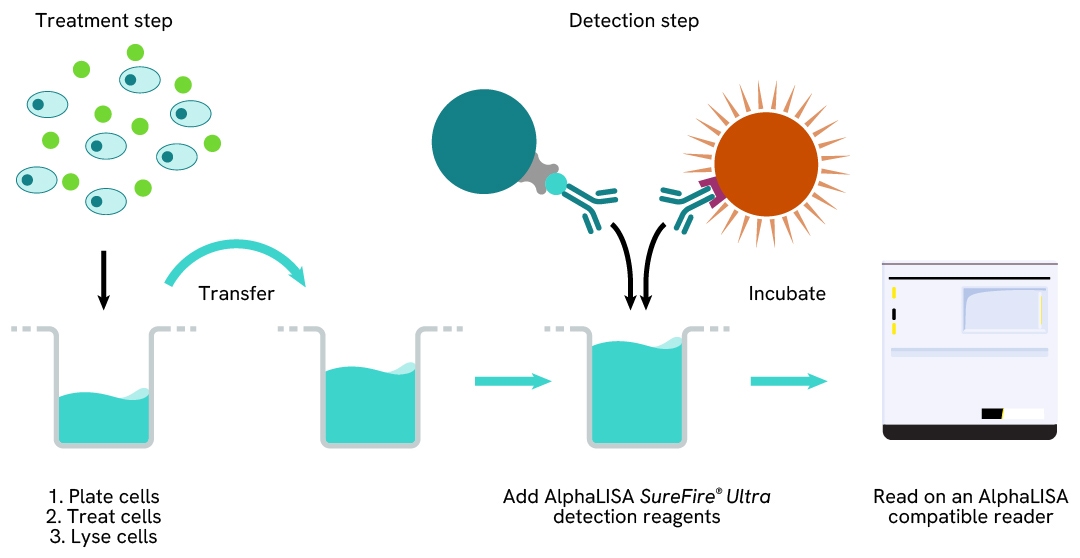
Phospho Aggregation-AlphaLISA SureFire Ultra one-plate assay protocol
Detection of aggregated target protein with AlphaLISA SureFire Ultra reagents can be performed in a single plate used for culturing, treatment, and lysis. No washing steps are required. This HTS designed protocol allows for miniaturization while maintaining robust AlphaLISA SureFire Ultra quality.
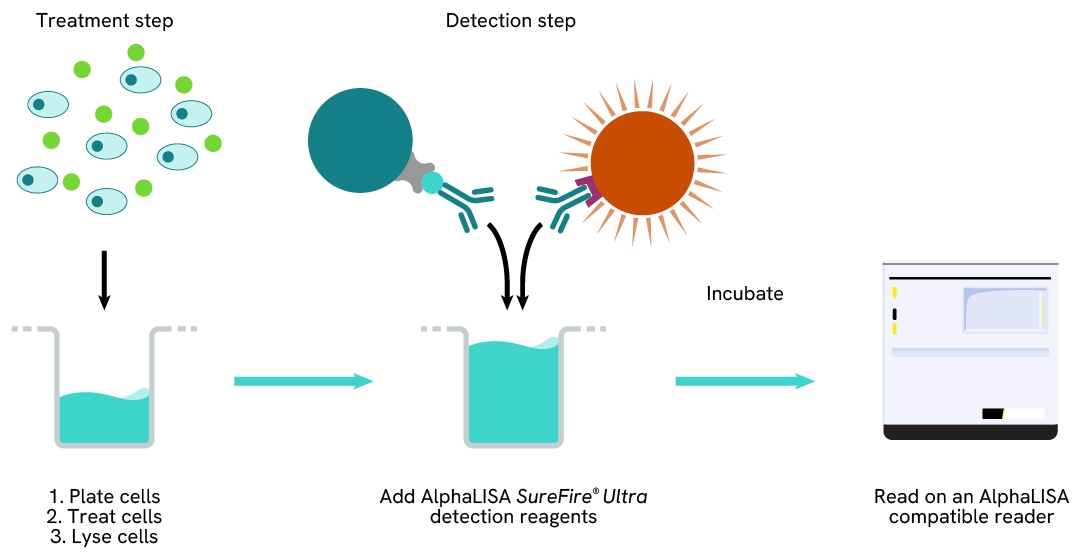
Assay specificity/selectivity
Selectivity of α-Synuclein Phospho (Ser129) Aggregate assay
Selectivity of the α-Synuclein Phospho (Ser129) Aggregate assay was assessed by assaying aggregated and monomeric proteins. Phosphorylated α-Synuclein aggregate (Abcam ab218819) and phosphorylated α-Synuclein monomer were prepared at approximately 250 ng/mL in Lysis Buffer and evaluated using the Phospho (Ser129) Aggregate AlphaLISA SureFire Ultra assay.
For the detection step, 10 µL of protein was transferred into a 384-well white OptiPlate, followed by 5 µL of Acceptor mix and incubated for 1 hour at room temperature. Finally, 5 µL of Donor mix was then added to each well and incubated for 1 hour at RT in the dark. The plate was read on an Envision using standard AlphaLISA settings.
α-Synuclein Phospho (Ser129) Aggregate assay recognizes phosphorylated α-Synuclein protein only when it is aggregated.
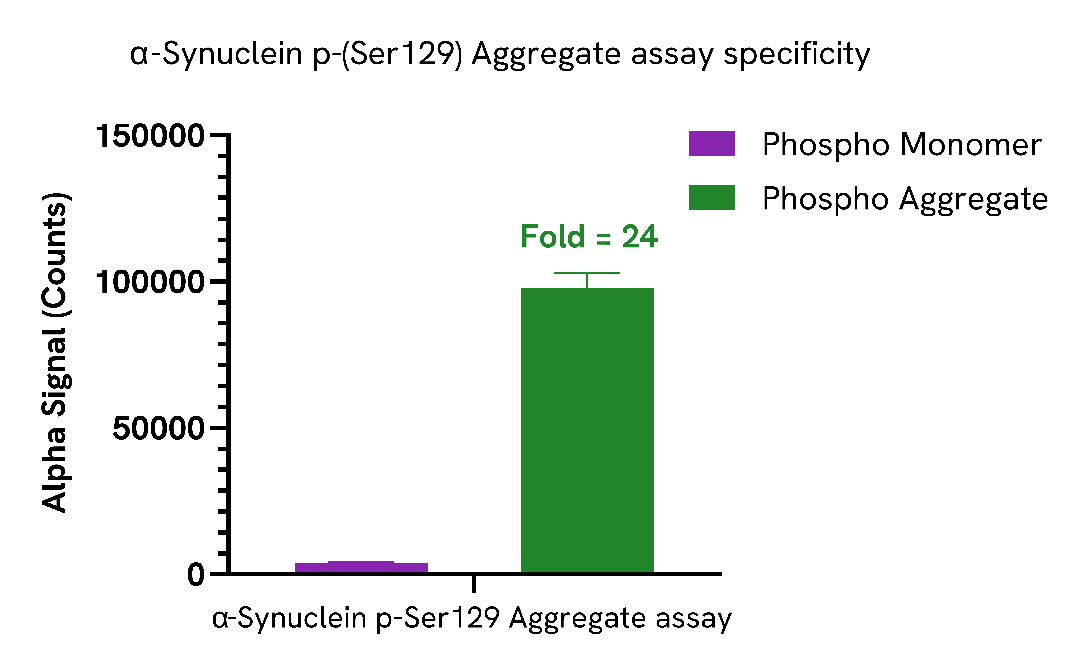
Specifications
| Application |
Cell Signaling
|
|---|---|
| Automation Compatible |
Yes
|
| Brand |
AlphaLISA SureFire Ultra
|
| Detection Modality |
Alpha
|
| Protocol Time |
2h at RT
|
| Sample Volume |
30 µL
|
| Shipping Conditions |
Shipped in Blue Ice
|
| Target |
α-Synuclein
|
| Target Class |
Phosphoproteins
|
| Target Species |
Human
Mouse
|
| Technology |
Alpha
|
| Therapeutic Area |
Neuroscience
|
| Unit Size |
100 assay points
|
Resources
Are you looking for resources, click on the resource type to explore further.
This publication review highlights the work of Trist et al. about the characterization of Alpha-Synuclein pathology in preclinical...
SDS, COAs, manuals and more
Are you looking for technical documents related to the product? We have categorized them in dedicated sections below. Explore now or request your COA/TDS, SDS, or IFU/manual.
- Lot NumberU21847Lot DateMay 19, 2025
- Lot NumberU21829Lot DateApril 14, 2025
- Lot Number-Lot Date-
- Resource TypeManualLanguage英语Country-


Recently viewed
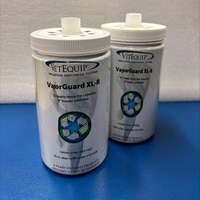
How can we help you?
We are here to answer your questions.
